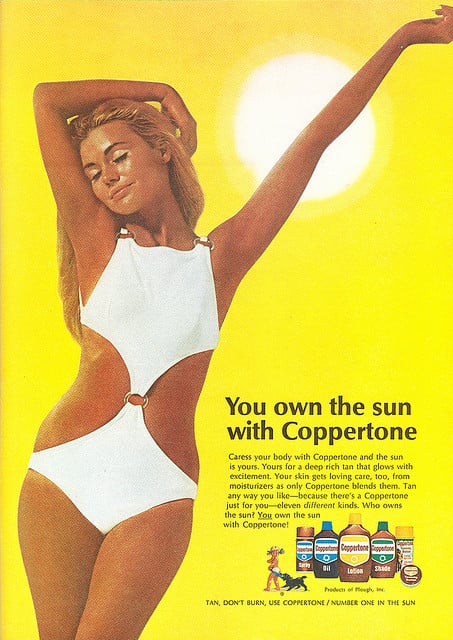Museum of Femoribilia (4)
By:
June 1, 2015

One in a series of 10 posts exhuming and interrogating forgotten curiosities and outmoded technologies of womanhood. Reprinted with permission from BUST Magazine.
“Nothing is as transient, useless, or completely desirable as a suntan,” wrote Gloria Steinem in The Beach Book (1963), a compendium of summer reading. Steinem, still an editor at Glamour and not yet a feminist icon, concluded it was justified because it would “make you look good.” But for many centuries before tanning became a fad in the 1920s, most women felt that sun-darkened skin made you look like a peasant.
Long before the industrial revolution of the nineteenth century, European women prized a creamy white skin as a sign of high status: laborers worked in the sun, ladies stayed indoors. Pale skin remained a beauty standard and helped reinforce the color line in the antebellum United States. Women used parasols, bonnets and gloves to ward off the sun’s rays.
By the late 1800s, as more people worked in factories, pale skin became a less reliable indicator of social status. Then, too, doctors discovered that there were some health benefits from sun exposure (particularly regarding rickets and tuberculosis).
Designer Coco Chanel did the most to make tanning fashionable. A 1918 photo showed the bareheaded iconoclast lying in the sun, yet wearing gloves: white, unmarred hands still marked a lady of leisure. When a deeply-bronzed Chanel returned from a vacation in the early 1920s and used tanned mannequins in her showroom, the die was cast. The body-conscious swimming suits and evening gowns of the 1920s and ’30s both showed off and reinforced the desirability of tanned skin.
The irony of white women (and men) roasting themselves to ever deeper shades while lynching and segregation were brutal facts of life was not unnoticed by those born with dark skin. Historian Kathy Peiss quoted from a 1925 African-American press account of the scene at a beach in Asbury Park, NJ. White lifeguards “burnt so dark that they were eligible for the jim-crow car” were envied, while black bathers were restricted to a corner where buildings obstructed their view of the water.
When Coppertone sold its first suntanning lotion in 1944 (with the slogan “Don’t Be a Paleface”), the summer tan was almost ubiquitous. Sporting a tan in the winter months became the new status symbol, as only the rich could travel to sun-drenched realms. In the 1950s, however, a sun lamp provided winter tans at the cost of a bulb. Instructional graphics showed men, women, and babies relaxing under the lamp’s “healthful” rays: “Get that summer-tan look all year ’round,” it promised. Even so, words of caution crept in. Users were warned against prolonged exposure with the bulb too close to the skin, and to shield their eyes.
Despite such warnings, tanners went dark, darker, darkest through the 1980s, when skyrocketing skin cancer rates became apparent. Pass the sunless tanner, please.
Originally published in BUST #29 (Fall 2004).
CURATED SERIES at HILOBROW: UNBORED CANON by Josh Glenn | CARPE PHALLUM by Patrick Cates | MS. K by Heather Kasunick | HERE BE MONSTERS by Mister Reusch | DOWNTOWNE by Bradley Peterson | #FX by Michael Lewy | PINNED PANELS by Zack Smith | TANK UP by Tony Leone | OUTBOUND TO MONTEVIDEO by Mimi Lipson | TAKING LIBERTIES by Douglas Wolk | STERANKOISMS by Douglas Wolk | MARVEL vs. MUSEUM by Douglas Wolk | NEVER BEGIN TO SING by Damon Krukowski | WTC WTF by Douglas Wolk | COOLING OFF THE COMMOTION by Chenjerai Kumanyika | THAT’S GREAT MARVEL by Douglas Wolk | LAWS OF THE UNIVERSE by Chris Spurgeon | IMAGINARY FRIENDS by Alexandra Molotkow | UNFLOWN by Jacob Covey | ADEQUATED by Franklin Bruno | QUALITY JOE by Joe Alterio | CHICKEN LIT by Lisa Jane Persky | PINAKOTHEK by Luc Sante | ALL MY STARS by Joanne McNeil | BIGFOOT ISLAND by Michael Lewy | NOT OF THIS EARTH by Michael Lewy | ANIMAL MAGNETISM by Colin Dickey | KEEPERS by Steph Burt | AMERICA OBSCURA by Andrew Hultkrans | HEATHCLIFF, FOR WHY? by Brandi Brown | DAILY DRUMPF by Rick Pinchera | BEDROOM AIRPORT by “Parson Edwards” | INTO THE VOID by Charlie Jane Anders | WE REABSORB & ENLIVEN by Matthew Battles | BRAINIAC by Joshua Glenn | COMICALLY VINTAGE by Comically Vintage | BLDGBLOG by Geoff Manaugh | WINDS OF MAGIC by James Parker | MUSEUM OF FEMORIBILIA by Lynn Peril | ROBOTS + MONSTERS by Joe Alterio | MONSTOBER by Rick Pinchera | POP WITH A SHOTGUN by Devin McKinney | FEEDBACK by Joshua Glenn | 4CP FTW by John Hilgart | ANNOTATED GIF by Kerry Callen | FANCHILD by Adam McGovern | BOOKFUTURISM by James Bridle | NOMADBROW by Erik Davis | SCREEN TIME by Jacob Mikanowski | FALSE MACHINE by Patrick Stuart | 12 DAYS OF SIGNIFICANCE | 12 MORE DAYS OF SIGNIFICANCE | 12 DAYS OF SIGNIFICANCE (AGAIN) | ANOTHER 12 DAYS OF SIGNIFICANCE | UNBORED MANIFESTO by Joshua Glenn and Elizabeth Foy Larsen | H IS FOR HOBO by Joshua Glenn | 4CP FRIDAY by guest curators
